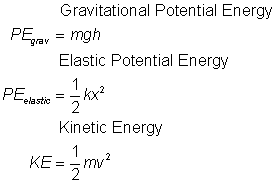Roller Coasters
| Home |
Potential
and Kinetic Energy |
Centripetal Forces |
Forces on a
Coaster |
Loop Design |
Bibliography |
Potential and Kinetic Energy
|
Conservation of Energy:
 Equations of PE and KE
 Photos: http://paphysics11.wikispaces.com/Physics+11+Energy+Group+2 |
The basics of how roller coasters
work is by taking the coaster up to the top of a very
tall hill and let it roll down. By taking the coaster
to the top of a hill, it increases the coasters
potential energy. This allows the coaster to gain
velocity and increase acceleration as it rolls down
the hill from all the potential energy converting to
kinetic energy. This gives the thrill of the high
speeds that that every one loves. If the potential
energy is great enough, then designers can include
many different features to the ride such as loops and
corkscrews, not just smaller hills.
Aside from dropping a cart
from the top of a hill to gain potential energy, some
coaster designs use spring and slingshot combination
to launch a coaster at high speeds. This is usually
used on short coasters that aim for the high-speed
factor to thrill the riders, or for those that are in
small confined areas where a large hill would not
work. This works by using the potential energy of
elasticity to increase the energy of the cart where a
spring is either pulled or compressed to launch an
object.
|